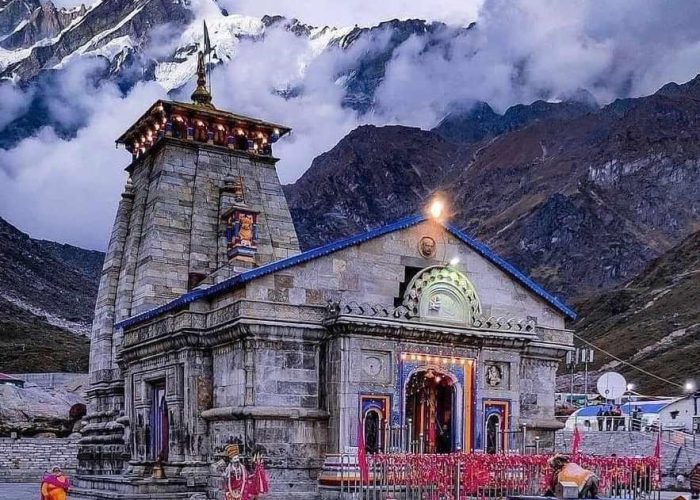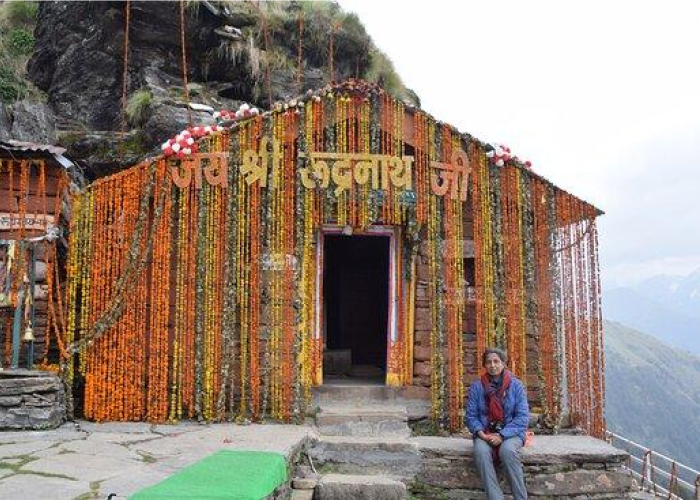Uttarakhand, often referred to as the “Land of the Gods,” is a region in Northern India that is blessed with stunning natural beauty and rich spiritual heritage. Nestled amidst the majestic Himalayas, this state is home to some of the most revered temples in the country. Pilgrims and spiritual seekers from all over the world flock to Uttarakhand to experience the divine energy and seek blessings at these sacred sites. In this article, we will explore the top 9 temples in Uttarakhand, each offering a unique blend of spirituality, architecture, and natural surroundings.

Kedarnath Temple
The Kedarnath Temple, situated in the Garhwal region of Uttarakhand, is a highly revered shrine dedicated to Lord Shiva. It holds immense historical and religious significance for Hindus.
A. Historical significance of Kedarnath Temple
The history of the Kedarnath Temple dates back thousands of years. It is believed to have been built by the Pandavas, the legendary heroes of the Hindu epic Mahabharata. According to mythology, the temple was re-established by Adi Shankaracharya in the 8th century to revive Hinduism in the region.
B. Unique architectural features of the temple
The architecture of Kedarnath Temple is a testament to the ancient skills of Indian craftsmen. The temple follows the traditional North Indian style, characterised by stone walls, ornate carvings, and a tall spire. The imposing structure against the backdrop of the snow-capped Himalayan peaks creates a mesmerising sight.
C. Spiritual practices and rituals at Kedarnath
Kedarnath Temple is not only a place of worship but also a centre for spiritual practices and rituals. Devotees engage in various rituals such as Rudrabhishek, where water is poured over the Shiva Lingam while reciting Vedic hymns. The temple premises resonate with the sounds of chants and prayers, creating an atmosphere of devotion and spiritual transcendence.

Badrinath Temple
Badrinath Temple, located in the Chamoli district of Uttarakhand, is one of the holiest shrines in Hinduism. It is an integral part of the Char Dham Yatra, which is believed to provide salvation to the pilgrims.
A. Importance of Badrinath as one of the Char Dham pilgrimage sites
Badrinath is one of the four pilgrimage sites, collectively known as Char Dham, which are considered the most sacred in Hinduism. The journey to Badrinath is believed to cleanse the soul and lead to spiritual liberation. It is considered a crucial step towards attaining Moksha, the ultimate goal of life.
B. Intricate carvings and craftsmanship of Badrinath Temple
The Badrinath Temple is an architectural marvel that showcases intricate carvings and craftsmanship. The temple is adorned with intricate stone sculptures depicting various deities and mythological scenes. The exquisite detailing reflects the skill and devotion of the artisans of ancient times.
C. The legend of Lord Vishnu’s meditation at Badrinath
According to Hindu mythology, Lord Vishnu, the preserver of the universe, meditated at Badrinath for thousands of years. The deity in the temple is believed to be a self-manifested statue of Lord Vishnu, known as the Badrinath deity. The legend of Lord Vishnu’s meditation adds to the sanctity and spiritual aura of the temple.

Gangotri Temple
Gangotri Temple, located in the Uttarkashi district of Uttarakhand, is the sacred source of the holy River Ganges. It holds immense spiritual significance for Hindus and is an important pilgrimage site.
A. The mythological origins of the holy River Ganges
According to Hindu mythology, the River Ganges descended from heaven to cleanse humanity’s sins. Gangotri is believed to be the place where the river originated. It is said that King Bhagirath meditated and performed penance to bring the Ganges to earth to purify the souls of his ancestors.
B. Spiritual significance of Gangotri Temple
Gangotri Temple is considered the spiritual abode of the goddess Ganga, and pilgrims visit the temple to seek her blessings and attain spiritual purification. Taking a dip in the icy waters of the Ganges near the temple is believed to wash away sins and bestow spiritual enlightenment.
C. Scenic beauty and serene atmosphere surrounding the temple
The Gangotri Temple is located in a picturesque setting, surrounded by snow-capped peaks and lush greenery. The serene and tranquil atmosphere adds to the spiritual experience, allowing devotees to connect with nature and find solace in its beauty.

Yamunotri Temple
Yamunotri Temple, situated in the Uttarkashi district of Uttarakhand, is dedicated to the goddess Yamuna, the sister of the River Ganges. It is one of the Char Dham pilgrimage sites and holds great religious significance.
A. The source of River Yamuna and its religious significance
Yamunotri is believed to be the place where the River Yamuna originated. According to Hindu mythology, the goddess Yamuna is considered the daughter of the sun god, Surya, and the sister of the River Ganges. The temple is the starting point of the sacred Yamunotri Yatra.
B. Traditional rituals and festivals celebrated at Yamunotri
Yamunotri Temple is a hub of spiritual activities and rituals. Devotees take a dip in the icy waters of the Yamuna, seeking spiritual purification and liberation. The temple hosts various festivals, including Yamunotri Diwali and Yamuna Jayanti, where devotees gather to celebrate and offer prayers to the goddess Yamuna.
C. Trekking and adventure opportunities near Yamunotri Temple
Apart from its religious significance, Yamunotri offers thrilling trekking opportunities. The trek to Yamunotri takes visitors through rugged terrains, dense forests, and gushing waterfalls, providing an exhilarating experience amidst the majestic Himalayan landscapes.
Tungnath Temple

Tungnath Temple, located in the Rudraprayag district of Uttarakhand, is the highest Shiva temple in the world. It is renowned for its spiritual significance and breathtaking views of the Himalayas.
A. The highest Shiva temple in the world
Tungnath Temple, situated at an altitude of 3,680 meters above sea level, holds the distinction of being the highest Shiva temple globally. Its lofty location adds to its spiritual allure and attracts devotees and adventure enthusiasts alike.
B. Majestic Himalayan views from Tungnath
Visitors to Tungnath Temple are rewarded with panoramic views of the snow-capped Himalayan peaks. The awe-inspiring vistas of Nanda Devi, Chaukhamba, and other towering mountains create a sense of wonder and awe, making the spiritual journey even more remarkable.
C. Trekking route and the spiritual energy of Tungnath
The trek to Tungnath Temple is a thrilling adventure that takes visitors through picturesque meadows, dense forests, and charming villages. The serene and peaceful surroundings, coupled with the spiritual energy of the temple, provide a perfect setting for introspection and seeking divine blessings.
Rudranath Temple

Rudranath Temple, situated in the Chamoli district of Uttarakhand, is one of the Panch Kedar pilgrimage sites dedicated to Lord Shiva. It holds great religious significance and is known for its remote location and natural beauty.
A. Mystical stories and legends associated with Rudranath
Rudranath Temple is shrouded in mythical tales and legends. It is believed to be the place where Lord Shiva appeared as a bull to elude the Pandavas after the Kurukshetra War. The temple’s association with these legends adds an air of mysticism and intrigue to the pilgrimage.
B. Remote location and natural beauty of Rudranath
Rudranath Temple is situated amidst picturesque landscapes, surrounded by lush green meadows, dense forests, and towering mountains. Its remote location offers a serene and peaceful environment, far away from the chaos of modern life.
C. The spiritual journey and meditation at Rudranath
Visiting Rudranath Temple involves a trek through breathtaking natural landscapes, which becomes a spiritual journey in itself. The serene and tranquil atmosphere of the temple provides an ideal setting for meditation and deep introspection, allowing visitors to connect with their inner selves and the divine presence of Lord Shiva.
Jageshwar Dham

Jageshwar Dham, located in the Almora district of Uttarakhand, is an archaeological marvel comprising a cluster of ancient temples. It is known for its architectural grandeur, intricate stone carvings, and spiritual ambience.
A. The cluster of ancient temples at Jageshwar
Jageshwar Dham is home to over 100 ancient temples dedicated to various Hindu deities. These temples, dating from the 9th to the 13th centuries, form a magnificent complex that showcases the rich architectural heritage of the region.
B. Architectural marvels and intricate stone carvings
The temples of Jageshwar Dham exhibit intricate stone carvings, reflecting the architectural brilliance of the bygone era. Elaborate sculptures, ornate pillars, and delicate detailing captivate visitors and provide a glimpse into the artistic excellence of ancient Indian craftsmen.
C. The spiritual ambience and festivals at Jageshwar Dham
Jageshwar Dham exudes a spiritual aura that envelopes visitors as they step into its sacred precincts. The serene atmosphere, combined with the rhythmic chanting of prayers and the fragrance of incense, creates an ambiance of devotion and inner peace. The annual Jageshwar Monsoon Festival, celebrated with great fervour, adds to the spiritual vibrancy of the place.
Neelkanth Mahadev Temple

Neelkanth Mahadev Temple, located near Rishikesh in the Pauri Garhwal district of Uttarakhand, is dedicated to Lord Shiva. It is renowned for its mythological significance, breathtaking location, and spiritual energy.
A. Mythological significance of Neelkanth Mahadev
According to Hindu mythology, Neelkanth Mahadev is the place where Lord Shiva consumed the poison that emerged during the churning of the celestial ocean, turning his throat blue. The temple stands as a testament to this divine event and holds deep significance for Lord Shiva’s devotees.
B. The breathtaking location amidst lush green mountains
Neelkanth Mahadev Temple is nestled amidst the lush green mountains of the Garhwal Himalayas. The pristine surroundings, gurgling streams, and tranquil ambiance create an atmosphere of serenity and spiritual rejuvenation, captivating visitors with their natural beauty.
C. Pilgrimage and spirituality at Neelkanth Mahadev
Pilgrims visit Neelkanth Mahadev Temple to seek the blessings of Lord Shiva and experience spiritual bliss. The temple becomes a sanctuary for introspection, meditation, and communion with the divine. The spiritual energy that pervades the place enhances the overall pilgrimage experience.
Baijnath Temple

Baijnath Temple, located in the Bageshwar district of Uttarakhand, is an ancient shrine dedicated to Lord Shiva. It is renowned for its historical significance, unique architectural blend, and spiritual aura.
A. Historical background of Baijnath Temple
Baijnath Temple has a rich historical legacy that dates back to the 12th century. It was constructed during the reign of the Katyuri dynasty, who were patrons of art and architecture. The temple stands as a testament to their grandeur and devotion to Lord Shiva.
B. The unique blend of Nagara and Dravidian architectural styles
Baijnath Temple showcases a unique fusion of Nagara and Dravidian architectural styles. The temple complex features intricate stone carvings, exquisite sculptures, and elaborate pillars, reflecting the artistic brilliance of ancient Indian craftsmen.
C. The spiritual aura and healing properties of Baijnath
Baijnath Temple is not only a place of religious worship but also a centre for spiritual healing. Devotees believe that the temple possesses healing powers, particularly for ailments related to eyes and ears. The spiritual aura that permeates the temple premises provides solace and rejuvenation to those who seek it.
Conclusion
Uttarakhand’s top 9 temples offer a rich tapestry of spirituality, architecture, and natural beauty. Each temple holds its unique charm and significance, captivating visitors with its history, mythology, and spiritual ambiance. These sacred sites provide a gateway to connect with the divine, find inner peace, and immerse oneself in the rich religious heritage of Uttarakhand. Whether it is the grandeur of Kedarnath, the tranquillity of Gangotri, or the mystical allure of Rudranath, these temples beckon pilgrims and spiritual seekers, offering an unforgettable journey of the soul amidst the awe-inspiring landscapes of the Himalayas


